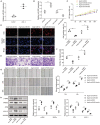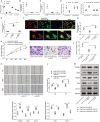Circ_0022920 Maintains the Contractile Phenotype of Human Aortic Vascular Smooth Muscle Cells Via Sponging microRNA-650 and Promoting Transforming Growth Factor Beta Receptor 1 Expression in Angiotensin II-Induced Models for Aortic Dissection
- PMID: 36974747
- PMCID: PMC10122879
- DOI: 10.1161/JAHA.122.027425
Circ_0022920 Maintains the Contractile Phenotype of Human Aortic Vascular Smooth Muscle Cells Via Sponging microRNA-650 and Promoting Transforming Growth Factor Beta Receptor 1 Expression in Angiotensin II-Induced Models for Aortic Dissection
Abstract
Background Abnormal regulation of vascular smooth muscle cells is regarded as the iconic pathological change of aortic dissection (AD). Herein, we aim to identify circ_0022920 as a crucial regulator in AD. Methods and Results Microarray analysis of circular RNAs, messenger RNAs, and micro RNAs in patients with AD was performed, and we identified that circ_0022920 was significantly downregulated in these patients. The Pearson correlation analysis uncovered the negative correlation between miR-650 and circ_0022920 or TGFβR1 (transforming growth factor beta receptor 1). Angiotensin II was used to treat human aortic vascular smooth muscle cells (HASMCs) and mice as models for AD. Hematoxylin and eosin and Masson's trichrome staining were used to analyze AD histopathology. Cell proliferation was analyzed with Cell Counting Kit-8 assay and EdU incorporation. Cell migration was assessed with transwell and wound healing assays. Enhanced circ_0022920 expression dramatically inhibited HASMC proliferation and migration and maintained contractile marker expression induced by angiotensin II, whereas miR-650 exerted opposite effects. MiR-650 was a target of circ_0022920. MiR-650 targeted IRF1 (interferon regulatory factor 1) and thus negatively regulated TGFβR1 expression to promote HASMC proliferation and migration and inhibit contractile marker expression. Circ_0022920 suppressed the progression of AD in vivo. Conclusions Circ_0022920 modulates the contractile phenotype of HASMCs via regulating the miR-650-IRF1-TGFβR1 axis in angiotensin II-induced models for AD, which provides potential therapeutic targets for AD.
Keywords: Circ_0022920; aortic dissection; contractile phenotype; miR‐650/IRF1/TGFβR1 axis.
Figures








Similar articles
-
Identification of the CeRNA axis of circ_0000006/miR-483-5p/KDM2B in the progression of aortic aneurysm to aorta dissection.BMC Cardiovasc Disord. 2025 Feb 28;25(1):141. doi: 10.1186/s12872-025-04598-8. BMC Cardiovasc Disord. 2025. PMID: 40021969 Free PMC article.
-
LncRNA SENCR overexpression attenuated the proliferation, migration and phenotypic switching of vascular smooth muscle cells in aortic dissection via the miR-206/myocardin axis.Nutr Metab Cardiovasc Dis. 2022 Jun;32(6):1560-1570. doi: 10.1016/j.numecd.2022.03.004. Epub 2022 Mar 8. Nutr Metab Cardiovasc Dis. 2022. PMID: 35351345
-
miR-335-5p regulates the proliferation, migration and phenotypic switching of vascular smooth muscle cells in aortic dissection by directly regulating SP1.Acta Biochim Biophys Sin (Shanghai). 2022 Jul 25;54(7):961-973. doi: 10.3724/abbs.2022081. Acta Biochim Biophys Sin (Shanghai). 2022. PMID: 35866606 Free PMC article.
-
circ_TGFBR2 Inhibits Vascular Smooth Muscle Cells Phenotypic Switch and Suppresses Aortic Dissection Progression by Sponging miR-29a.J Inflamm Res. 2021 Nov 9;14:5877-5890. doi: 10.2147/JIR.S336094. eCollection 2021. J Inflamm Res. 2021. PMID: 34795497 Free PMC article.
-
Circ_0000006 and circ_0000160 regulate hsa-let-7e-5p/UBQLN4 axis in aortic dissection progression.PLoS One. 2024 May 31;19(5):e0304668. doi: 10.1371/journal.pone.0304668. eCollection 2024. PLoS One. 2024. PMID: 38820386 Free PMC article.
Cited by
-
WTAP Silencing protects human aortic smooth muscle cells from angiotensin II-induced senescence, apoptosis, ferroptosis, and inflammation by regulating PCSK9.J Bioenerg Biomembr. 2025 Jul 11. doi: 10.1007/s10863-025-10065-y. Online ahead of print. J Bioenerg Biomembr. 2025. PMID: 40643726
-
Comparative Analysis of Circular RNAs Expression and Function between Aortic and Intracranial Aneurysms.Curr Drug Targets. 2024;25(13):866-884. doi: 10.2174/0113894501319306240819052840. Curr Drug Targets. 2024. PMID: 39219419 Free PMC article. Review.
-
Circular RNA in Cardiovascular Diseases: Biogenesis, Function and Application.Biomolecules. 2024 Aug 6;14(8):952. doi: 10.3390/biom14080952. Biomolecules. 2024. PMID: 39199340 Free PMC article. Review.
References
-
- Juang D, Braverman AC, Eagle K. Cardiology patient pages. Aortic dissection. Circulation. 2008;118:e507–e510. - PubMed
Publication types
MeSH terms
Substances
LinkOut - more resources
Full Text Sources

